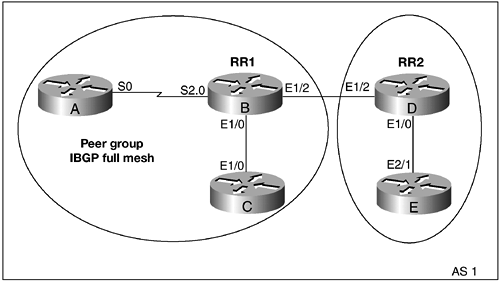3-5 bgp client-to-client reflection
| < Free Open Study > |
3-5 bgp client-to-client reflectionSyntax Description: This command has no arguments. Purpose: When a router is configured as a route reflector, client-to-client reflection is enabled by default. If the route reflector's clients are fully meshed, client-to-client reflection can be disabled on the route reflector using the no form of the command. Cisco IOS Software Release: 11.1 Configuration Example: Route Reflectors and Peer GroupsAn obvious question is why use a route reflector if the clients have a full IBGP mesh? If client-to-client reflection is enabled, the clients cannot be part of a peer group. Figure 3-5 demonstrates a situation in which we want to scale the IBGP connections using route reflectors, but we also want Routers A, B, and C to be part of the same peer group . Therefore, client-to-client reflection needs to be disabled on Router B. The total number of IBGP connections is still reduced, even though the clients are fully meshed. Routers B and D need to be configured as route reflectors. If B and D were not route reflectors, a full mesh would be required between all five routers. A route reflector is set up by configuring Routers A and C as route reflector clients on Router B. But because the clients are fully meshed, route reflection can be disabled on Router B. Figure 3-5. Route Reflectors and Peer Groups Router A interface Serial0 ip address 193.16.0.2 255.255.255.252 VerificationVerify that the neighbors have been configured in the proper peer group and that the route reflector is enabled: rtrB# show ip bgp n BGP neighbor is 172.16.0.2, remote AS 1, internal link Member of peer-group group1 for session parameters BGP version 4, remote router ID 172.16.88.3 BGP state = Established, up for 00:11:33 Last read 00:00:34, hold time is 180, keepalive interval is 60 seconds Neighbor capabilities: Route refresh: advertised and received Address family IPv4 Unicast: advertised and received Received 115 messages, 0 notifications, 0 in queue Sent 110 messages, 0 notifications, 0 in queue Route refresh request: received 0, sent 0 Minimum time between advertisement runs is 5 seconds For address family: IPv4 Unicast BGP table version 4, neighbor version 4 Index 1, Offset 0, Mask 0x2 Route-Reflector Client group1 peer-group member BGP neighbor is 193.16.0.2, remote AS 1, internal link Member of peer-group group1 for session parameters BGP version 4, remote router ID 193.16.0.2 BGP state = Established, up for 00:12:07 Last read 00:00:08, hold time is 180, keepalive interval is 60 seconds Neighbor capabilities: Route refresh: advertised Address family IPv4 Unicast: advertised and received Received 108 messages, 0 notifications, 0 in queue Sent 108 messages, 0 notifications, 0 in queue Route refresh request: received 0, sent 0 Minimum time between advertisement runs is 5 seconds For address family: IPv4 Unicast BGP table version 4, neighbor version 4 Index 1, Offset 0, Mask 0x2 Route-Reflector Client group1 peer-group member 0 accepted prefixes consume 0 bytes Prefix advertised 0, suppressed 0, withdrawn 0 Troubleshooting
|
| < Free Open Study > |
EAN: 2147483647
Pages: 300

